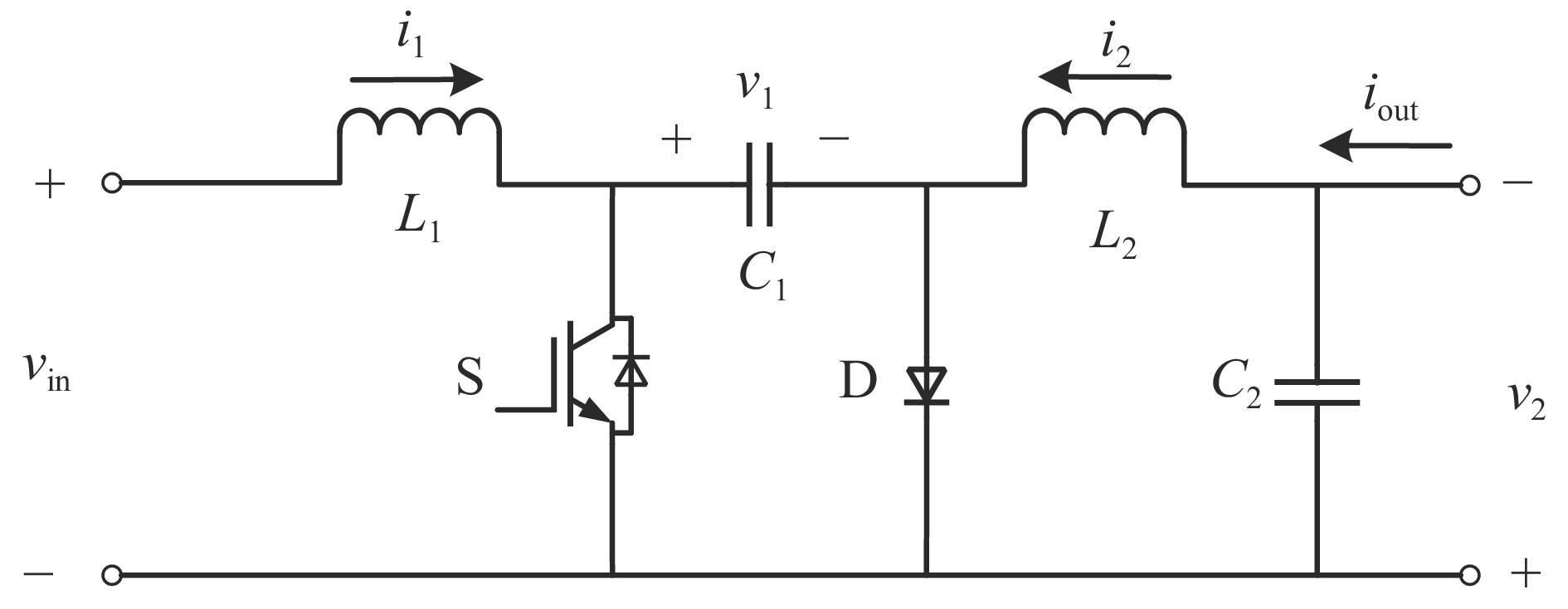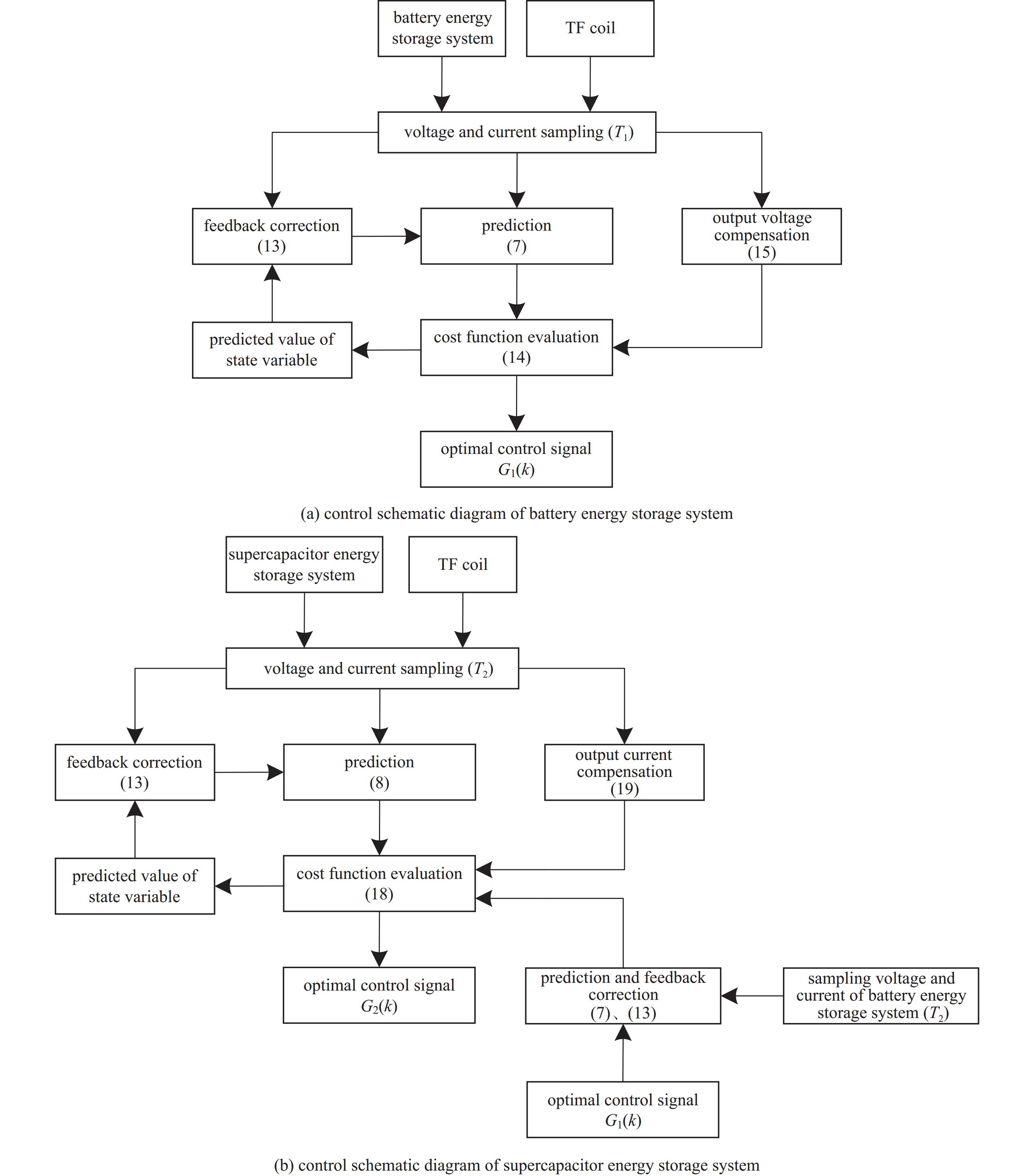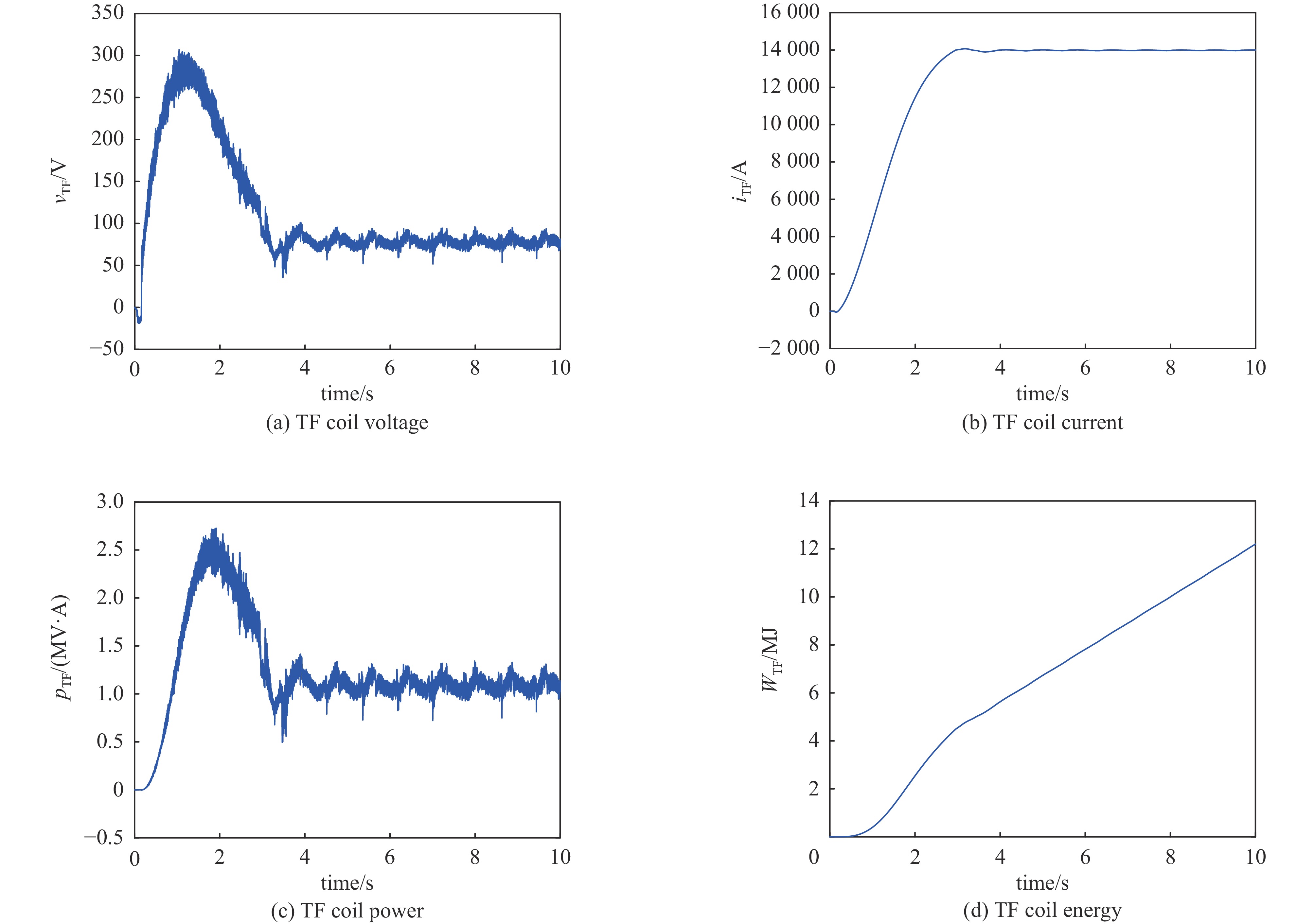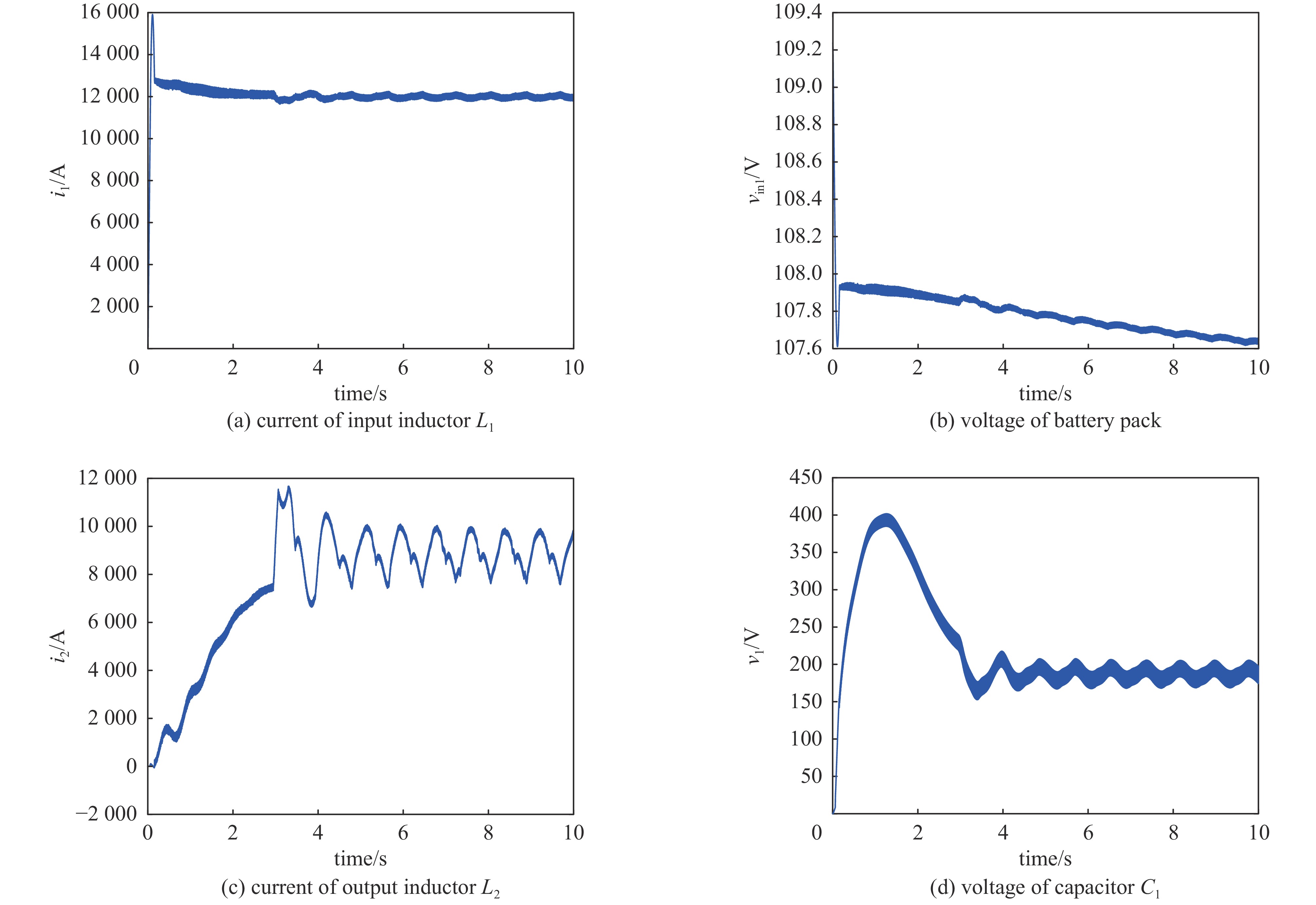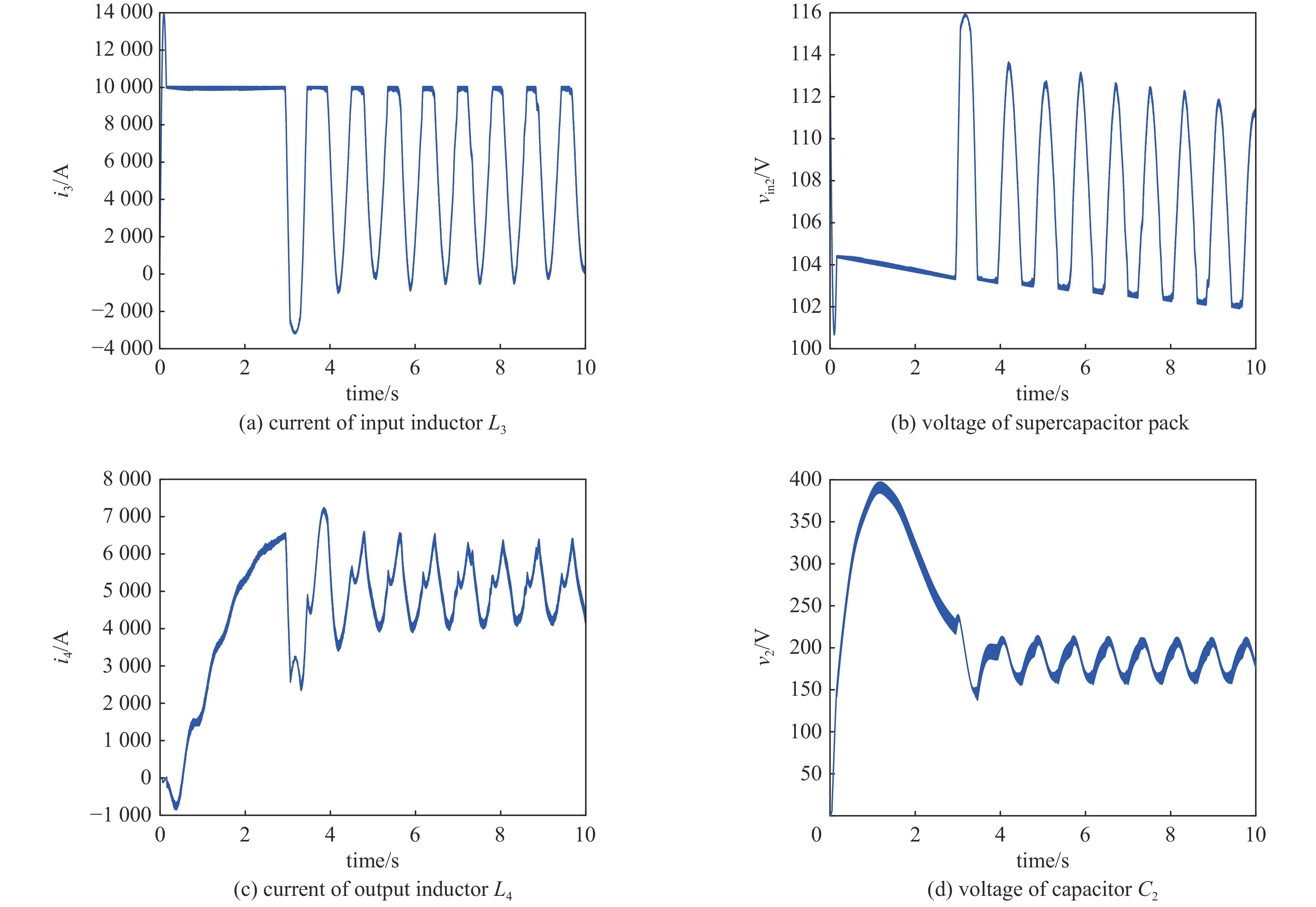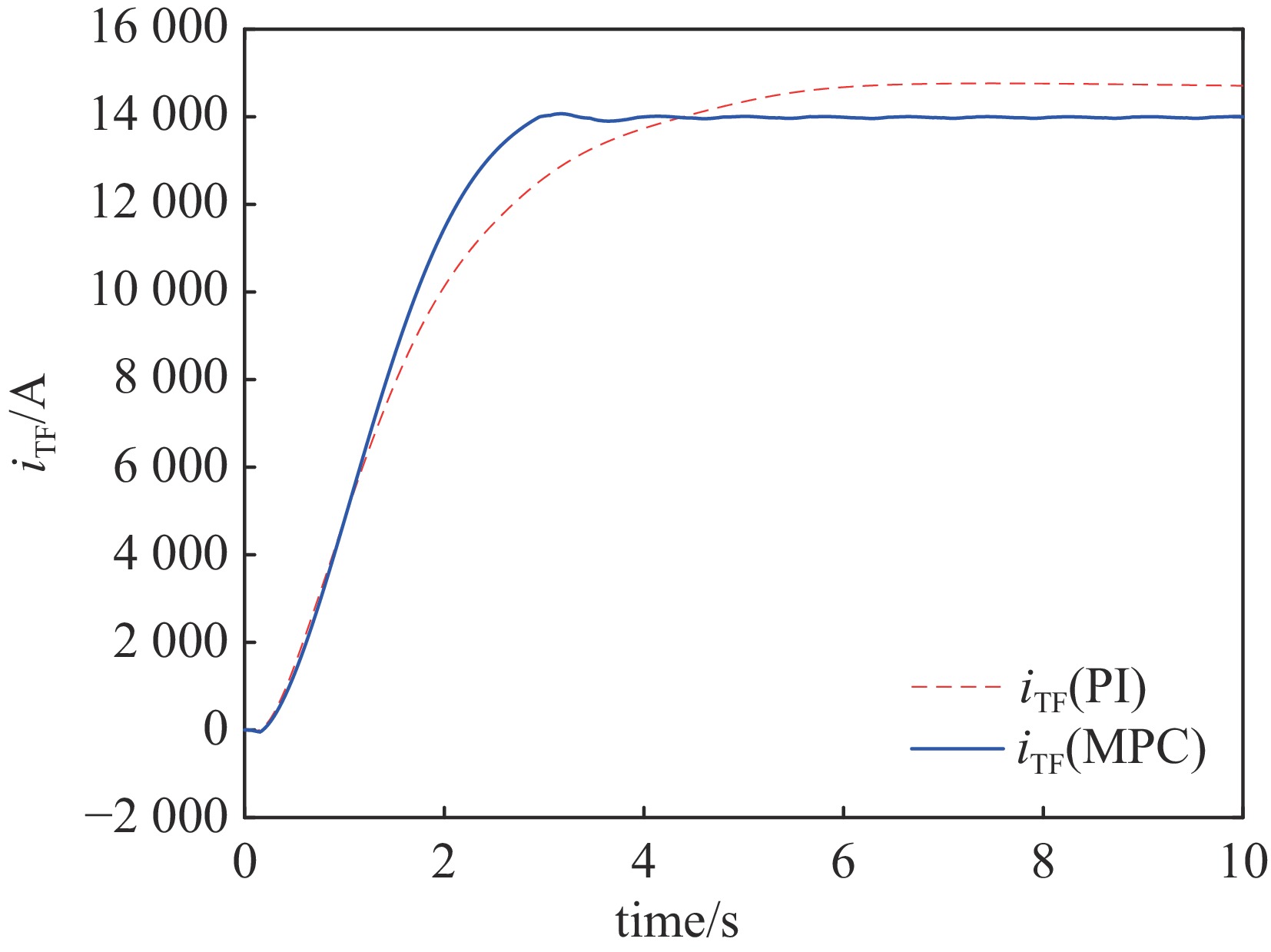Model predictive control of battery-supercapacitor hybrid energy storage system
-
摘要: 为匹配中国环流三号装置磁体线圈功率和能量需求,基于模型预测控制理论,设计电池-超级电容混合储能系统放电策略。以环向场线圈为储能系统输出端负载,建立系统预测模型,根据电池、超级电容特性和负载能量需求设计目标函数,实时求解最优开关序列。对电池储能子系统、超级电容储能子系统分别采用长周期慢控、短周期快控,实现电池稳定放电和超级电容瞬态响应。基于MATLAB/Simulink平台进行仿真验证,混合储能系统稳定输出满足负载需求的平顶电流,其电流纹波为0.22%,验证控制策略有效性。Abstract: A discharge strategy for a battery-supercapacitor hybrid energy storage system is designed based on model predictive control theory to match the power and energy requirement of the magnet coil of HL-3. Using toroidal field coil as the load of the energy storage system, the mathematical model of the system and the objective function based on battery/supercapacitor characteristics and energy demands of the load is established. The optimal switching sequence is solved in real time. Long cycle control is applied on battery energy storage system to achieve stable discharge of the battery, while short cycle control is applied on supercapacitor energy storage system to achieve transient response of the supercapacitor. Simulation experiments are conducted using MATLAB/Simulink. The hybrid energy storage system stably outputs a flat top current that meets the load demand, with a current ripple of 0.22%. The simulation results verify the effectiveness of the proposed control method.
-
表 1 TF线圈参数
Table 1. Parameters of TF coil
LTF/mH RTF/mΩ tflat/s iTF_flat/kA 32 5.6 7 140 表 2 仿真模型参数
Table 2. Parameters of simulation model
vB/V RB/mΩ RC/mΩ C/F L2, L4/mH vC(0)/V SSOC_B(0) 100 0.102 0.955 26400 0.6 114 0.8 C1, C2/F C3/μF L1, L3/mH rC/mΩ rL/mΩ LTF/mH RTF/mΩ 10 470×20 0.5 1 0.2 32 5.6 N1, N2 T1/ms T2/ms i1ref/kA i2ref/kA ISCmax/kA iTFref/kA 2 0.25 0.1 12 10 10 14 α1 β1_up β1_flat KPi KIi KPv KIv 0.9 0.9 0.5 2 0 5 10 -
[1] Zhong Wulyu, HL-3 Team. China's HL-3 tokamak achieves H-mode operation with 1 MA plasma current[J]. The Innovation, 2024, 5: 100555. [2] 宣伟民, 王英翘, 李华俊, 等. HL-2M装置供电系统研制[J]. 核聚变与等离子体物理, 2021, 41(s2):437-442Xuan Weimin, Wang Yingqiao, Li Huajun, et al. Development of HL-2M power supply system[J]. Nuclear Fusion and Plasma Physics, 2021, 41(s2): 437-442 [3] 袁保山, 龙永兴, 邱银, 等. HL-2M环向场线圈电磁场和受力的计算分析[J]. 核聚变与等离子体物理, 2017, 37(3):249-256Yuan Baoshan, Long Yongxing, Qiu Yin, et al. Electromagnetic calculation and load analysis of the HL-2M TF coils[J]. Nuclear Fusion and Plasma Physics, 2017, 37(3): 249-256 [4] 李逢兵. 含锂电池和超级电容混合储能系统的控制与优化研究[D]. 重庆: 重庆大学, 2015Li Fengbing. Control and optimization of hybrid energy storage systems containing lithium-ion batteries and super-capacitors[D]. Chongqing: Chongqing University, 2015 [5] Kollimalla S K, Mishra M K, Narasamma N L. Design and analysis of novel control strategy for battery and supercapacitor storage system[J]. IEEE Transactions on Sustainable Energy, 2014, 5(4): 1137-1144. doi: 10.1109/TSTE.2014.2336896 [6] 王红艳, 张文倩. 改进型逻辑门限混合储能系统控制策略研究[J]. 智慧电力, 2020, 48(5):41-46 doi: 10.3969/j.issn.1673-7598.2020.05.007Wang Hongyan, Zhang Wenqian. Control strategy of improved logic threshold hybrid energy storage system[J]. Smart Power, 2020, 48(5): 41-46 doi: 10.3969/j.issn.1673-7598.2020.05.007 [7] Essoufi M, Hajji B, Rabhi A. Fuzzy logic based energy management strategy for fuel cell hybrid electric vehicle[C]//Proceedings of 2020 International Conference on Electrical and Information Technologies. 2020: 1-7. [8] 吴铁洲, 薛竹山, 向富超, 等. 基于遗传算法的电动汽车HESS功率优化分配[J]. 电气传动, 2019, 49(2):49-55Wu Tiezhou, Xue Zhushan, Xiang Fuchao, et al. Optimization of HESS power allocation for electric vehicle based on genetic algorithm[J]. Electric Drive, 2019, 49(2): 49-55 [9] Javed M S, Ma Tao, Jurasz J, et al. Economic analysis and optimization of a renewable energy based power supply system with different energy storages for a remote island[J]. Renewable Energy, 2021, 164: 1376-1394. doi: 10.1016/j.renene.2020.10.063 [10] Khoobi Arani S, Niasar A H, Zadeh A H. Energy management of dual-source propelled electric vehicle using fuzzy controller optimized via genetic algorithm[C]//Proceedings of the 7th Power Electronics and Drive Systems Technologies Conference. 2016: 338-343. [11] Raveendran Nair U, Costa-Castelló R. A model predictive control-based energy management scheme for hybrid storage system in islanded microgrids[J]. IEEE Access, 2020, 8: 97809-97822. doi: 10.1109/ACCESS.2020.2996434 [12] Xiong Rui, Cao Jiayi, Yu Quanqing. Reinforcement learning-based real-time power management for hybrid energy storage system in the plug-in hybrid electric vehicle[J]. Applied Energy, 2018, 211: 538-548. doi: 10.1016/j.apenergy.2017.11.072 [13] Xiong Rui, Chen Huan, Wang Chun, et al. Towards a smarter hybrid energy storage system based on battery and ultracapacitor - A critical review on topology and energy management[J]. Journal of Cleaner Production, 2018, 202: 1228-1240. doi: 10.1016/j.jclepro.2018.08.134 [14] Santucci A, Sorniotti A, Lekakou C. Power split strategies for hybrid energy storage systems for vehicular applications[J]. Journal of Power Sources, 2014, 258: 395-407. doi: 10.1016/j.jpowsour.2014.01.118 [15] Kumar K, Bae S. Coordinated dynamic power management for renewable energy-based grid-connected microgrids using model predictive control[J]. IEEE Transactions on Industrial Informatics, 2023, 19(9): 9596-9608. doi: 10.1109/TII.2022.3231409 [16] 宋元明, 刘亚杰, 金光, 等. 锂离子电池/超级电容器混合储能系统能量管理方法综述[J]. 储能科学与技术, 2024, 13(2):652-668Song Yuanming, Liu Yajie, Jin Guang, et al. Review of energy management methods for lithium-ion battery/supercapacitor hybrid energy storage systems[J]. Energy Storage Science and Technology, 2024, 13(2): 652-668 [17] Song Ziyou, Hofmann H, Li Jiaqiu, et al. A comparison study of different semi-active hybrid energy storage system topologies for electric vehicles[J]. Journal of Power Sources, 2015, 274: 400-411. doi: 10.1016/j.jpowsour.2014.10.061 [18] Gorji S A, Sahebi H G, Ektesabi M, et al. Topologies and control schemes of bidirectional DC-DC power converters: an overview[J]. IEEE Access, 2019, 7: 117997-118019. doi: 10.1109/ACCESS.2019.2937239 [19] Jaga O P, Gupta R, Jena B, et al. Bi-directional DC/DC converters used in interfacing ESSs for RESs and EVs: a review[J]. IETE Technical Review, 2023, 40(3): 334-370. doi: 10.1080/02564602.2022.2116362 -




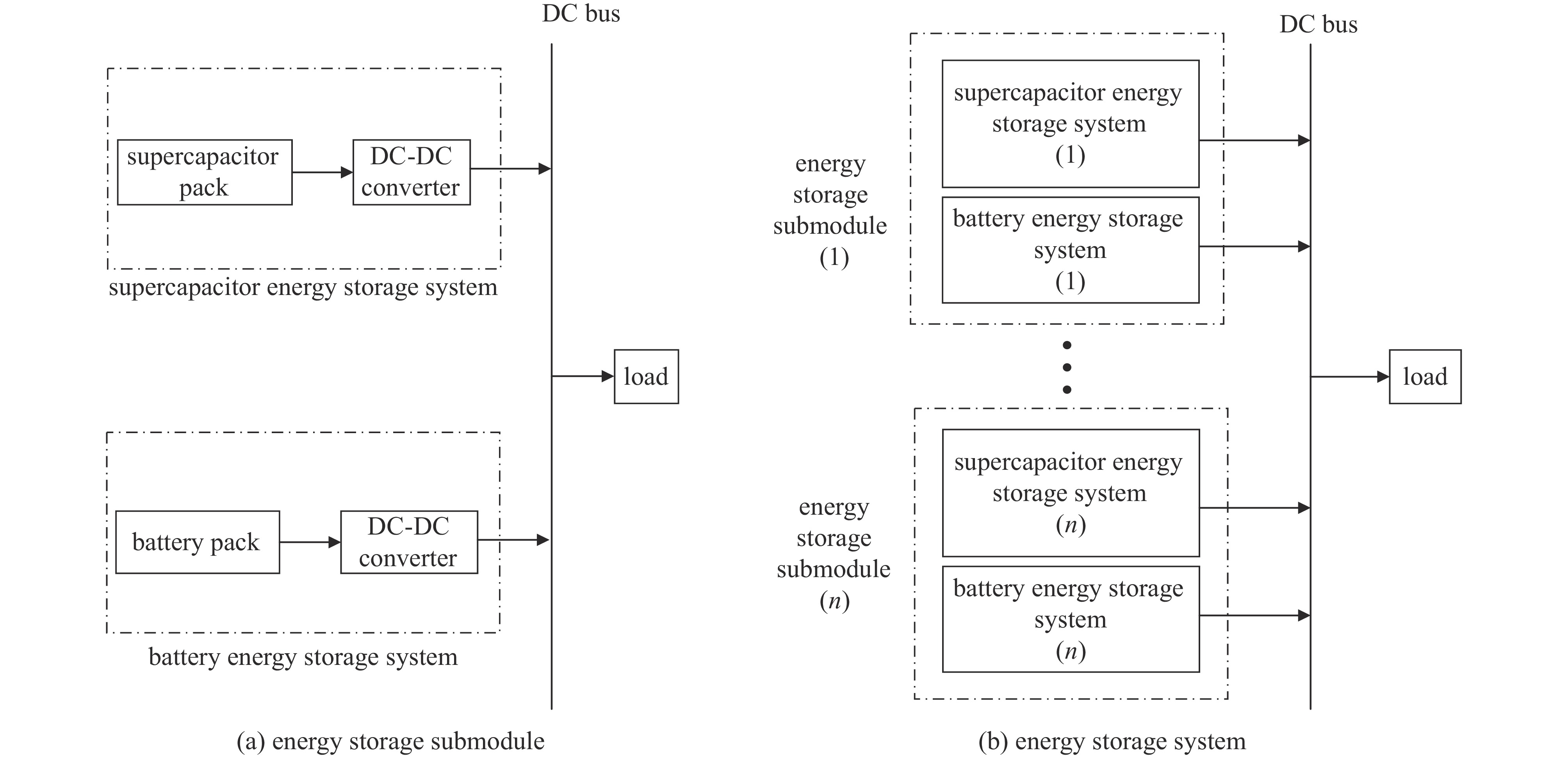
 下载:
下载:
